10 Most Valuable Modern Quarters Worth Money.
Posted by Andrew Adamo on Feb 19th 2025
What Quarters are Worth Money? 10 Most Valuable Quarters Worth Money List.
If you have ever wondered what quarters are worth money, you may think that it's only old coins that are worth more than face value. However, there are many rare quarters worth money. There are a good amount of valuable quarters still circulating that are valuable because of their series, condition, or mint date. If you’re curious to know what quarters you should keep an eye out for, we’ve put together a list of valuable quarters after 1965 for you! Keep reading to learn more about the top ten rare quarters worth money.
Rare Quarters
Rare quarters are highly sought after by coin collectors due to their scarcity, historical significance, and unique features. These quarters often include limited mintage issues, error coins, and those with significant historical or design changes. Examples of rare quarters include the 1932-D and 1932-S Washington Quarters, the 1896-S Barber Quarter, and the 1970-S Proof Washington Quarter with a doubled die obverse. The value of these rare quarters can range from a few hundred to several thousand dollars, depending on their condition and rarity.
What Quarters Are Worth Money?
It’s important to know what characteristics to look for so one of these rare quarters doesn’t slip through your pocket change without being noticed.
One of the quickest ways to determine what quarters are worth money is to verify the date and mint mark. 1964 is one of the key dates to remember since that was the last year silver quarters were struck.
Modern quarters that were produced after that year may be worth a premium in Mint State condition or if they’re one of the rarest commemorative quarters.
1964 Denver Mint Mark George Washington Quarter - $8,000
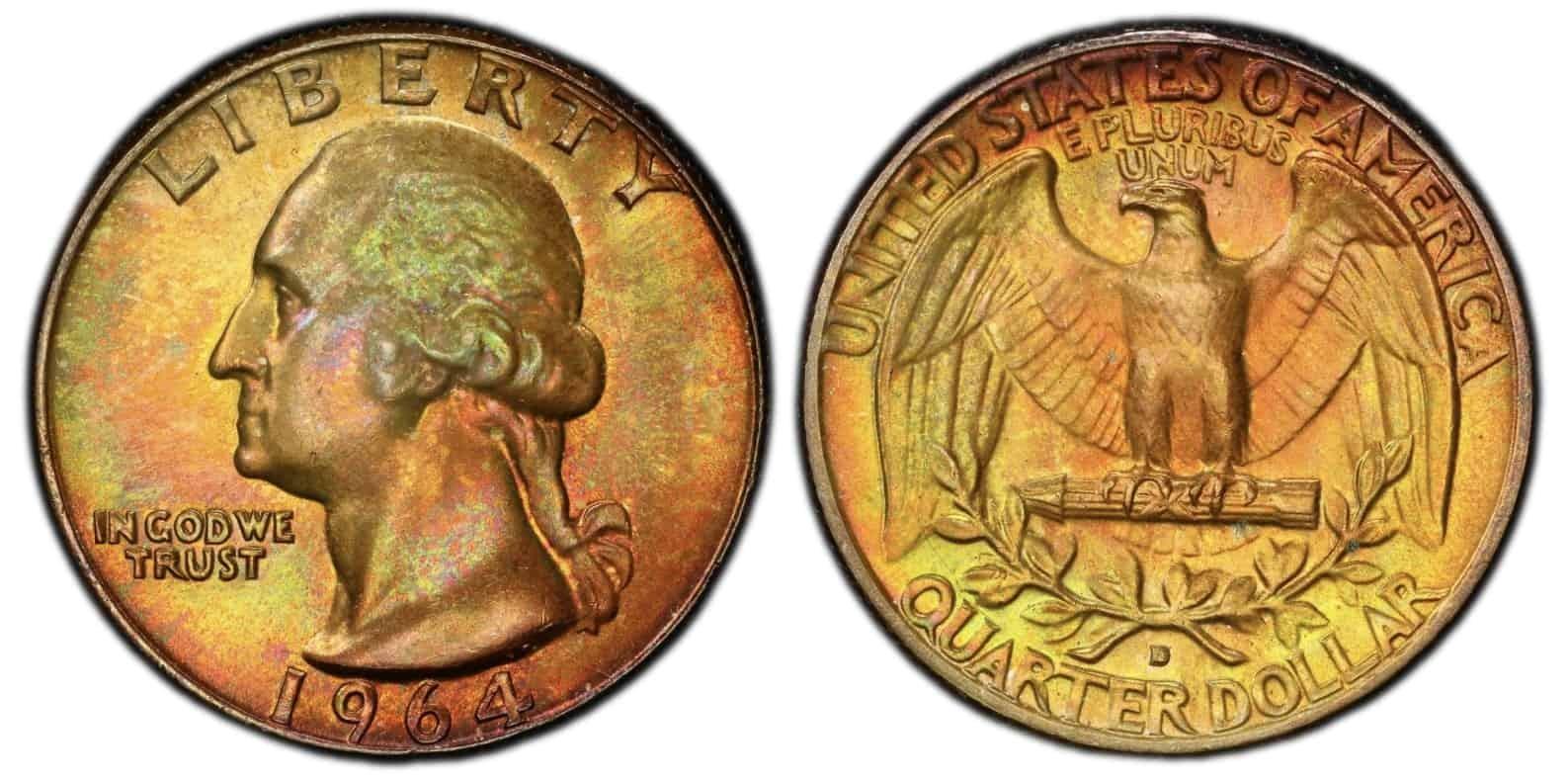
Silver quarters minted in 1964 are some of the most valuable U.S. quarters because there is a greater amount of silver content in old U.S. quarters. The 1964 George Washington Quarter has a minimum coin value of $4.02 each but may be worth more depending on the condition and mint mark.
Only two U.S. Mints struck Washington quarters in 1964, the Philadelphia Mint and the Denver Mint. You can quickly tell them apart by the “D” mint mark on the reverse design of coinage from the Denver Mint. 1964 is the year that Washington quarters had their mint marks on the reverse side. Silver coins issued from Philadelphia are typically unmarked and may be worth a small premium. The silver content in these coins is what makes these quarters worth money.
The highest recorded auction price for a 1964 Denver Mint Mark George Washington Quarter is approximately $8,000. This price reflects the coin's rarity in exceptional condition, such as MS-67, and is particularly notable for any errors or high-quality examples from the Denver Mint.
1965 MS67+ Washington Modern Quarter - $12,000
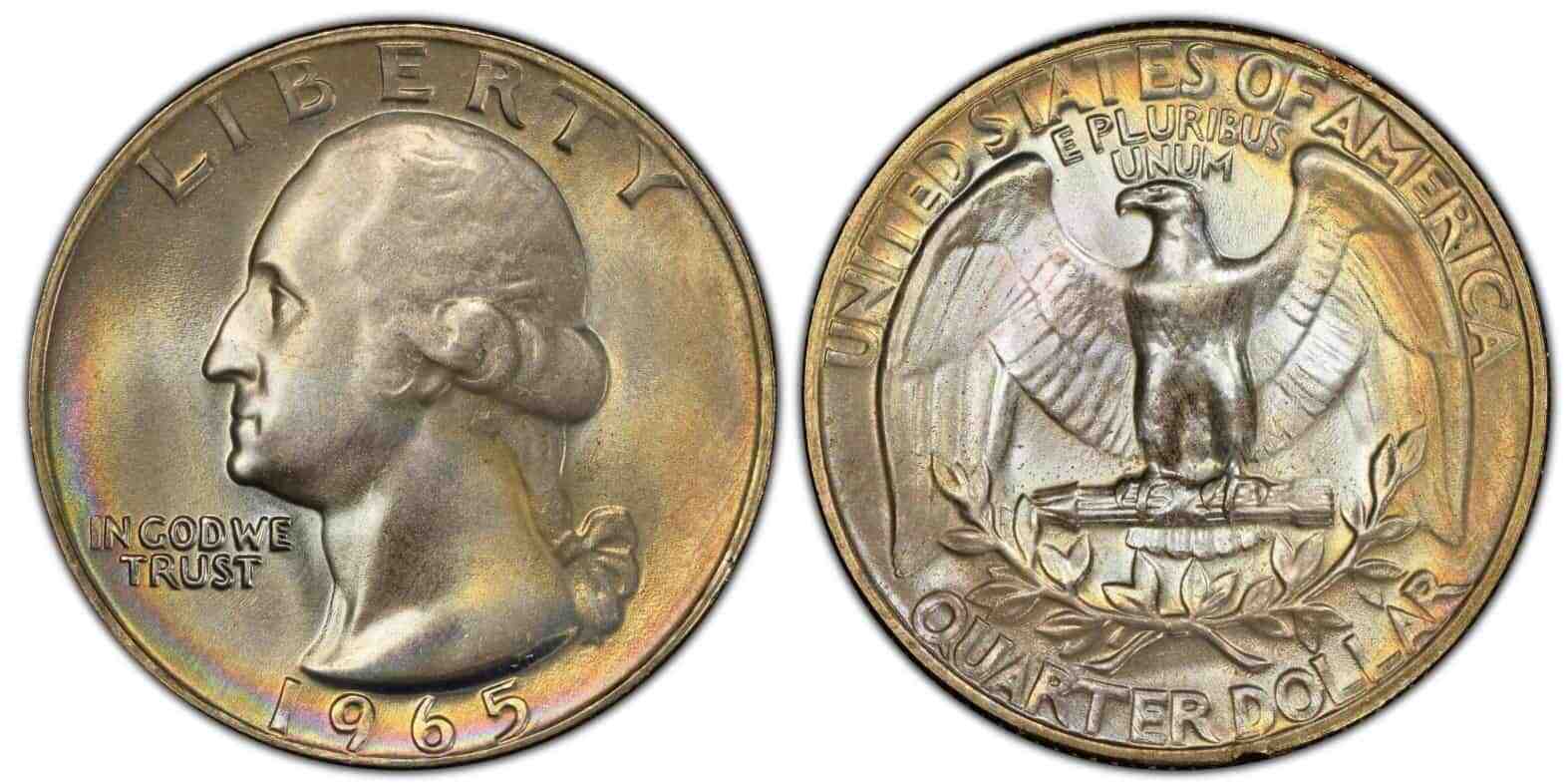
1965 George Washington quarters graded MS67 are one of the quarters worth money to keep an eye out for. These quarters are commonly sought-after by coin collectors due to their scarcity. There are only 50 known examples of this date in that grade, and none of them are said to be in higher condition.
1965 is a key date because it marks the first year the U.S. Mint struck Clad Washington Quarters. Quarter dollar coins struck in 1965 for circulation are somewhat scarce in MS65 condition and a little more scarce in MS66 condition, with around a few thousand examples in existence.
The highest recorded auction price for a 1965 MS67+ Washington Quarter is approximately $12,000. This value is for a coin in exceptional condition with the MS67+ grade, reflecting its rarity and high quality among modern quarters.
1971-S Washington Quarter - $3,500
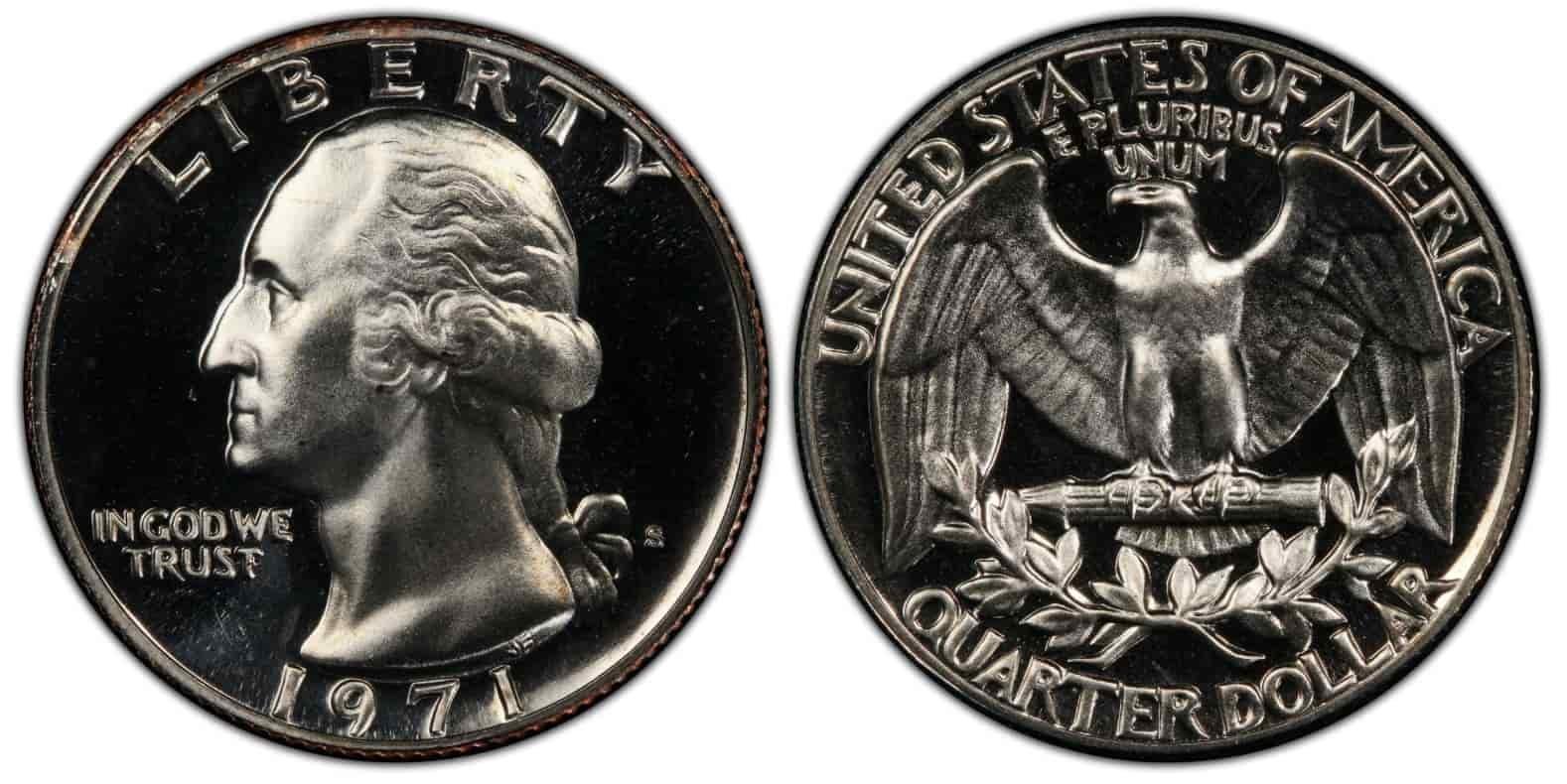
If you're looking for what quarters are worth money, look no further than the 1971 Washington Quarter bearing the “S” mint mark of the infamous San Francisco Mint. It is fairly common in most grades, however it may be one of the more valuable U.S. coins if it’s in excellent Mint State (MS+) condition.
Finding a 1971-S Proof Washington Quarter in PR68 Deep Cameo or higher is difficult as they’re very scarce. These coveted proof coins are even harder to find in high-grade Proof Cameo and Deep Cameo condition than silver quarters issued in the 1960s.
You’ll find the well-known portrait of George Washington facing left on the coin’s obverse and a large eagle clutching logs with wings fully extended on the reverse, as on all quarters issued from 1964 to 1998.
The highest recorded auction price for a 1971-S Washington Quarter is approximately $3,500. This value typically reflects a coin in exceptional condition, such as a high-grade proof or an error variety, making it notable among collectors.
1967 SMS Washington Quarter - $17,000
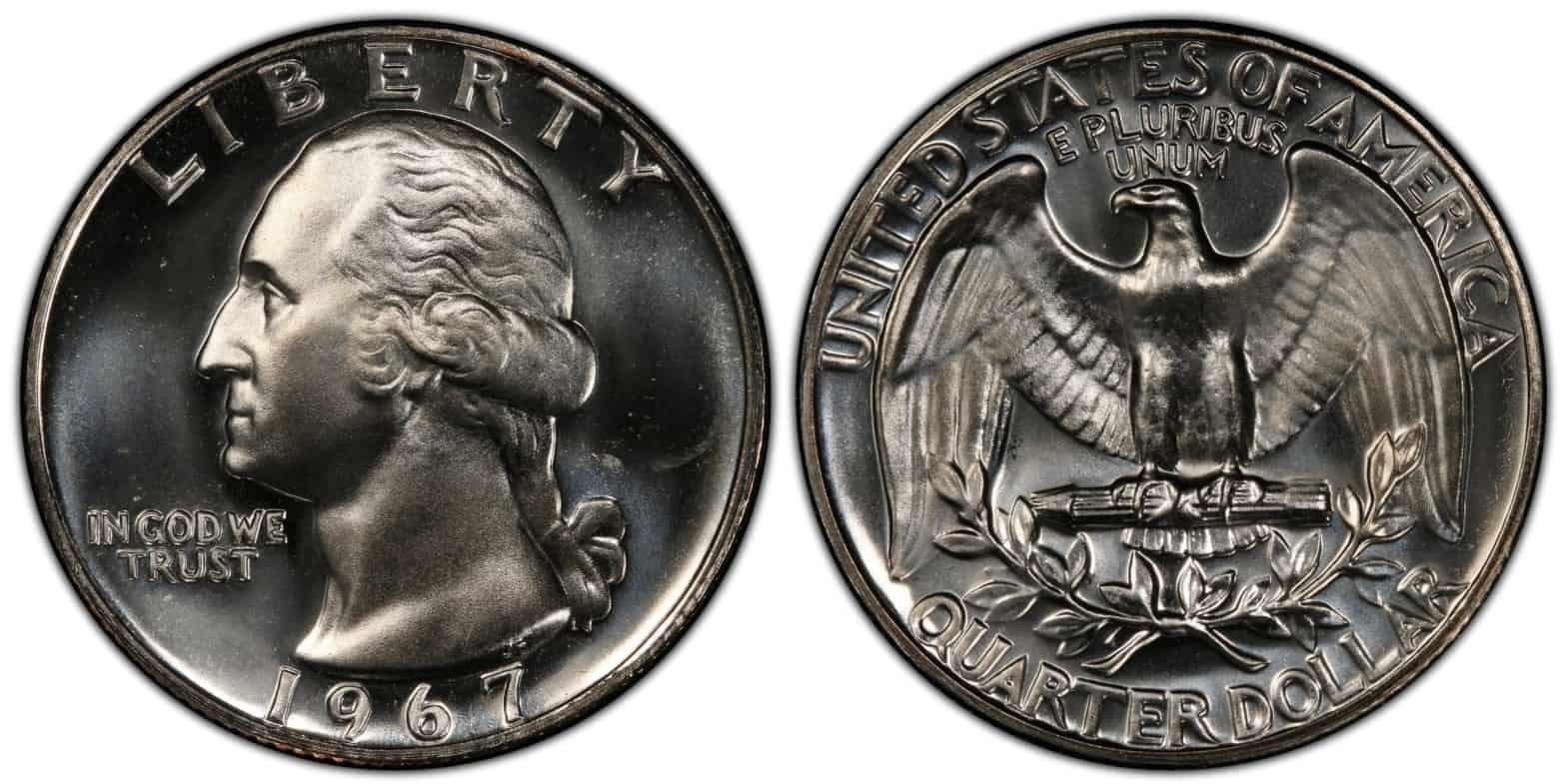
1967 Washington Quarters are one of the most popular quarters for coin collecting. If you can find one of these silver quarters in high grades or uncirculated condition, it could be worth thousands.
In 1964, the United State Mint needed to resolve a coin shortage and therefore ceased production of normal proof coins and sets for a short period of time. Instead, they created the Special Mint Set (SMS) that were not quite proofs, but still of higher quality than normal coins in circulation.
These special mint sets were only issued in 1965, 1966, and 1967 while the US Mint was transitioning the production of proof coins from the Philadelphia Mint to the San Francisco Mint. The limited nature of the SMS quarters makes them one of the best modern quarters worth money.
The highest recorded auction price for a 1967 SMS (Special Mint Set) Washington Quarter is approximately $17,000. This price is typically for a coin in exceptional condition, such as a high-grade MS or proof example, reflecting its rarity and desirability among collectors.
1982 Washington Quarter - $8,500
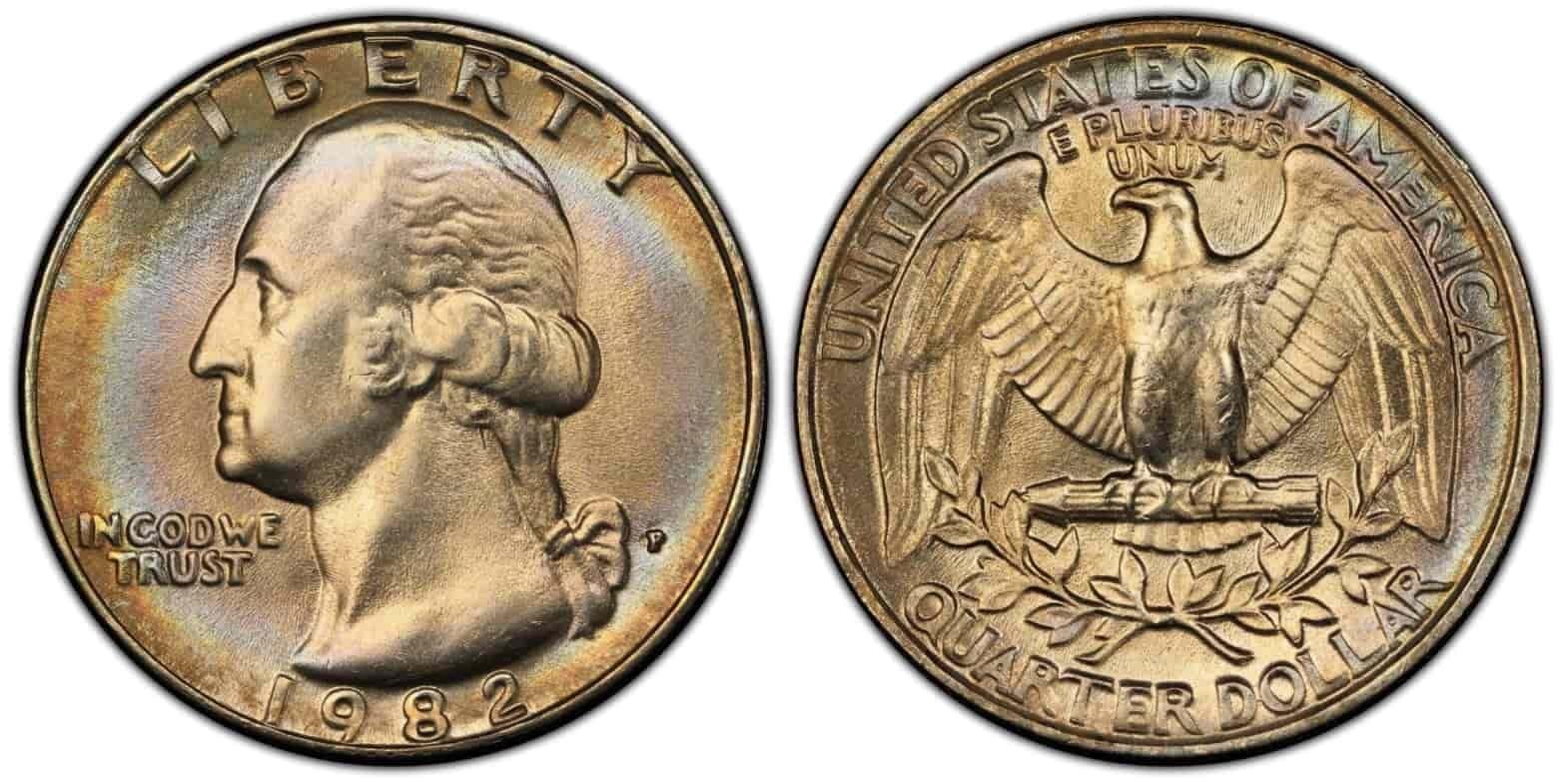
Since they’re not extremely old, you may be surprised to find out that 1982 Washington Quarters are one of the many modern quarters worth money. These scarce coins are worth adding to your coin collection.
They were struck when America was experiencing a recession, and people were holding onto their money versus spending. The U.S. Mint did not issue any traditional Mint Sets during the years 1982 and 1983.
Since the Mint did not issue uncirculated Mint Sets, they’re much harder to find in Mint State grades. It is tough to find a 1982 Washington Quarter in MS65 condition, considered scarce in MS66 condition, and even more challenging to find one graded as MS67.
The highest recorded auction price for a 1982 Washington Quarter is approximately $8,500. This value generally reflects a coin in exceptional condition, such as MS-67 or higher, with particular attention to any rare errors or variations that may enhance its value.
1966 Washington Quarter - $8,000
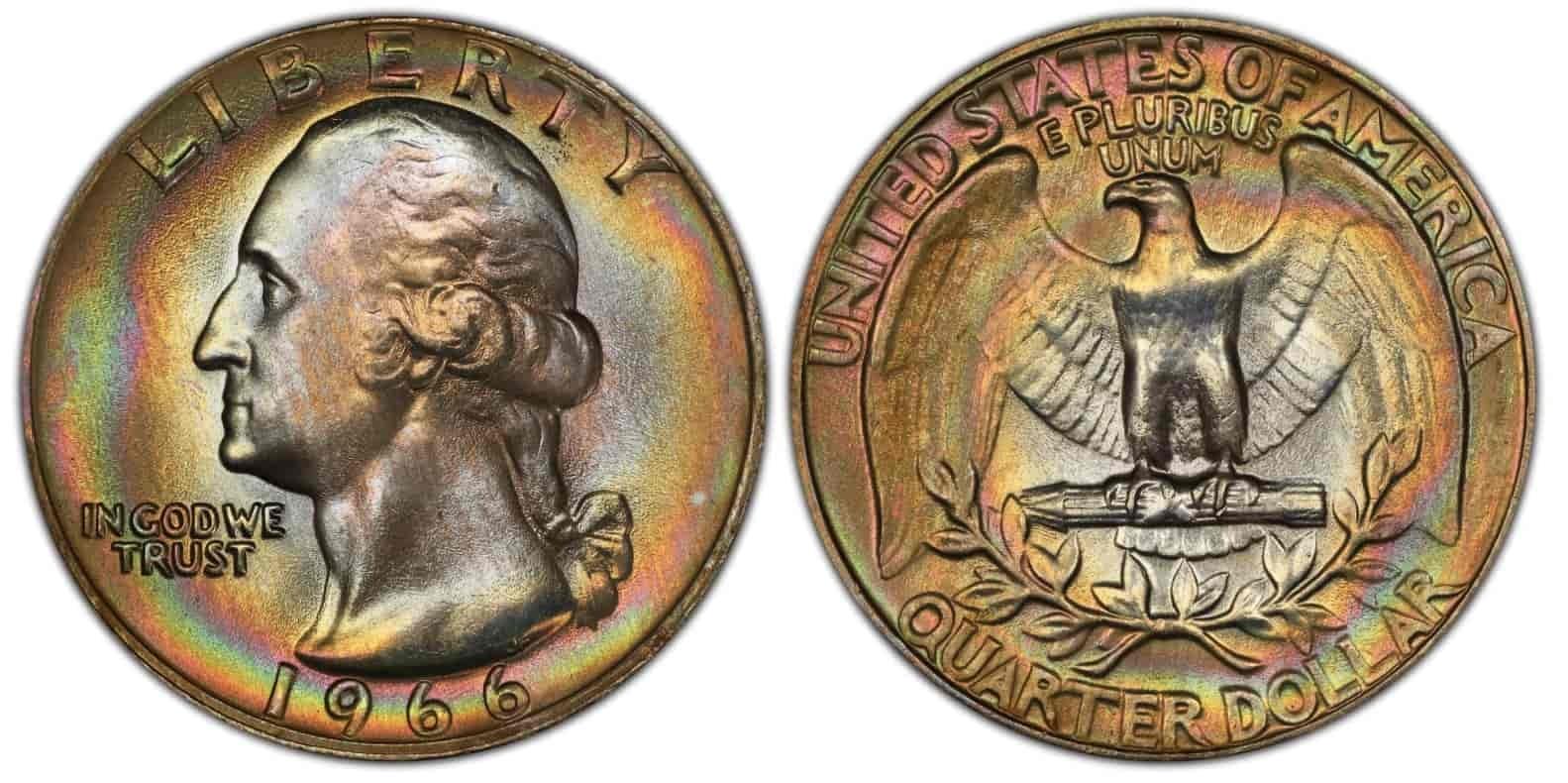
A regular strike 1966 Washington Quarter is a very common coin still in circulation today. Over 800 million of these U.S. quarters were struck. They range in value quite a bit according to wear and tear.
Numismatists assess the value of examples according to their current condition when deciding what quarters are worth money. Keep a close eye on your pocket change because examples can still be found circulating in about MS60-MS63 condition.
It can be tougher to find 1966 quarters graded as MS64-MS66. However, they can be purchased relatively inexpensively. Washington Quarters from 1966 in MS67 condition are very scarce, with less than a hundred known examples graded by PCGS.
The highest recorded auction price for a 1966 Washington Quarter is approximately $8,000. This price typically reflects a coin in exceptional condition, such as MS-67 or higher, and may also be influenced by specific error varieties or unique features.
1968-S U.S. Mint Mark Quarter - $4,500
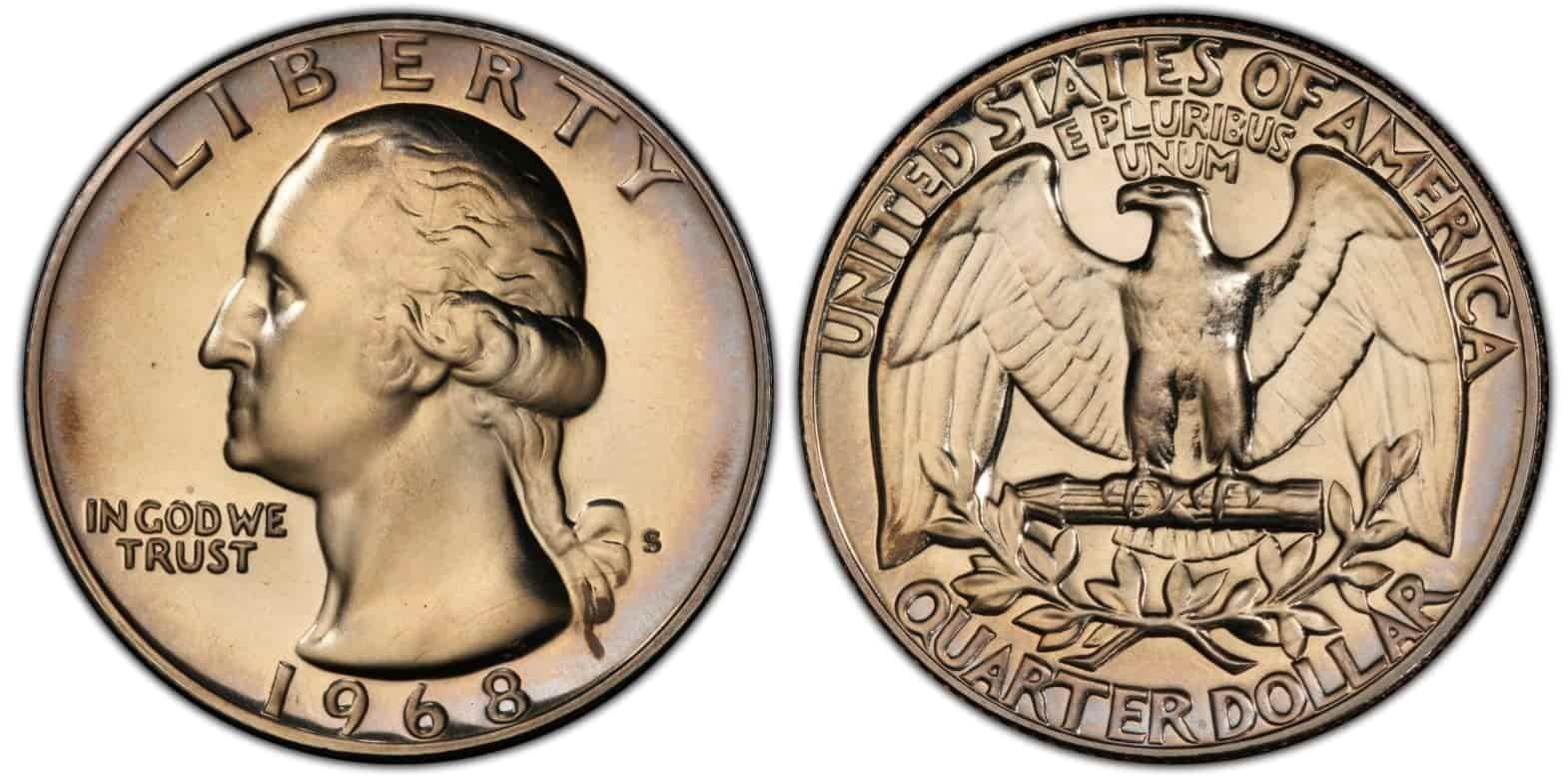
1968 S Washington Quarters are valuable coins for a couple of reasons. This was the year that mint marks returned to U.S. quarters. There was also a dramatic decrease in quarter production.
The San Francisco Mint, which stopped producing circulating quarters in 1955, restarted production in 1968 but only as proof coins. Only 321 million quarters were minted between the Denver and Philadelphia Mints.
Additionally, this is the year when the “S” mint mark was moved from the reverse design to the obverse of the coin.
The highest recorded auction price for a 1968-S Washington Quarter is approximately $4,500. This value usually reflects a coin in exceptional condition, such as a high-grade proof or an error variety. The 1968-S quarter is notable for its quality in the proof sets produced by the San Francisco Mint.
1986-P Washington Quarter - $4,500
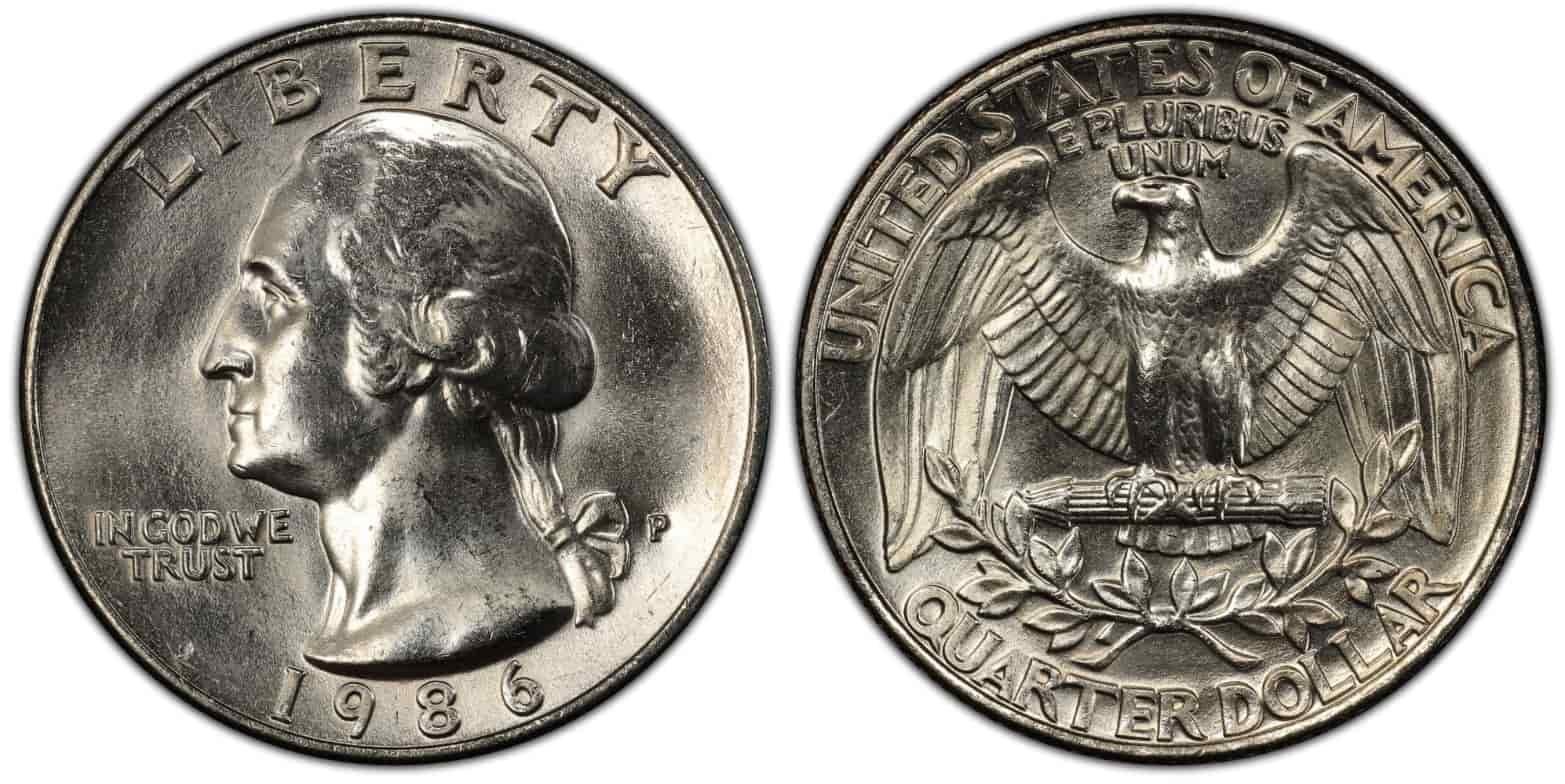
The 1986 regular strike Washington Quarter is a great example of a modern quarter worth money. That year, silver quarters were struck at three United State Mint branches: Philadelphia, San Francisco, and Denver.
A quarter from 1986 with a “P” mint mark would have been struck at the Philadelphia Mint as a “Mint Strike” for everyday use. A large number of these U.S. coins were struck, but they’re harder to find in excellent condition since most were used in daily transactions. There are only ten known examples in MS67 condition.
The highest recorded auction price for a 1986-P Washington Quarter is approximately $4,500. This value is typically for a coin in exceptional condition, such as MS-67 or higher, and may also be influenced by any rare errors or unique features that enhance its desirability among collectors.
1970-S Washington Quarter - $4,500
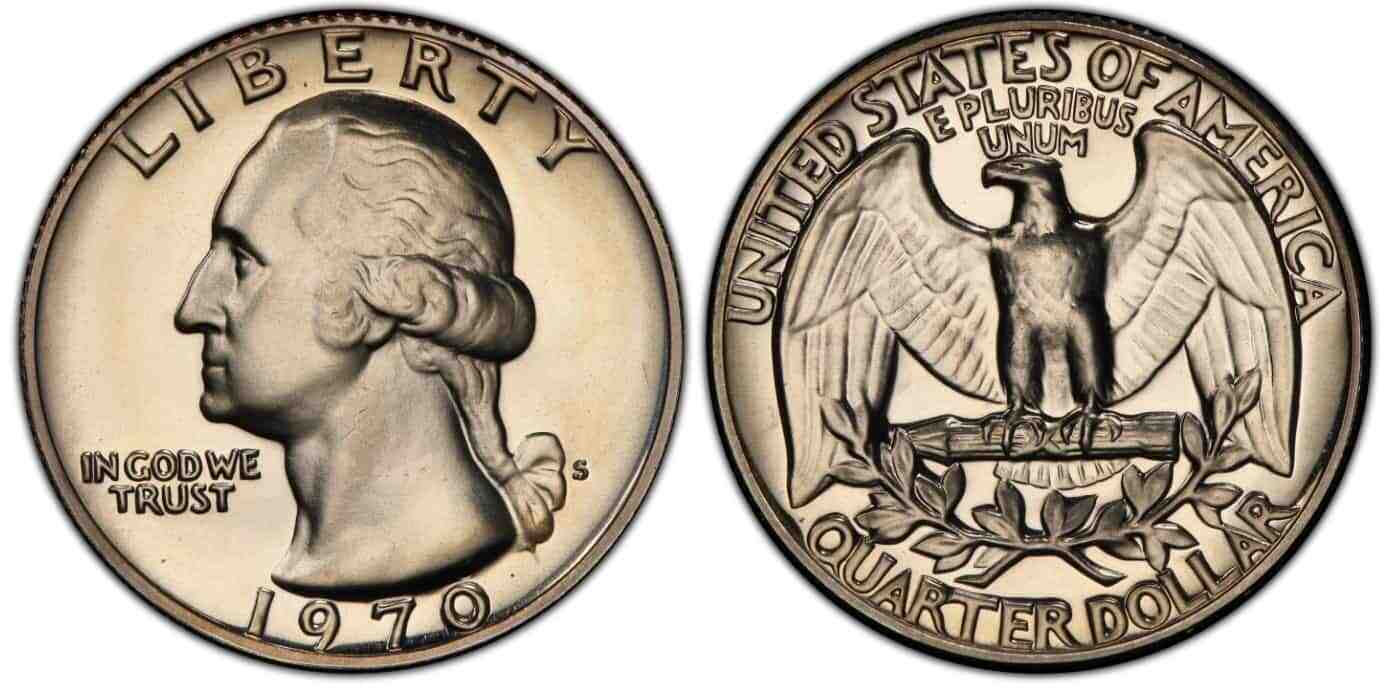
The 1970-S Washington Quarter was only struck as a proof coin at the San Francisco Mint. These clad composition silver quarters have a mintage of over two million, so they’re not exactly rare. but in pristine condition they are considered to be one of the most collectible quarters worth money.
Uncirculated examples of the 1970-S Washington Quarter are fairly common in grades up to about PR69. They’re much tougher to find in PR69 Deep Cameo, with probably less than 100 examples out there.
There are very valuable error quarters from this series, including one struck over a Canadian quarter from 1941.
The highest recorded auction price for a 1970-S Washington Quarter is approximately $4,500. This price generally reflects a coin in exceptional condition, such as MS-67 or higher, and may include specific errors or unique attributes that contribute to its value.
1965 Washington MS68 Quarter - $15,000
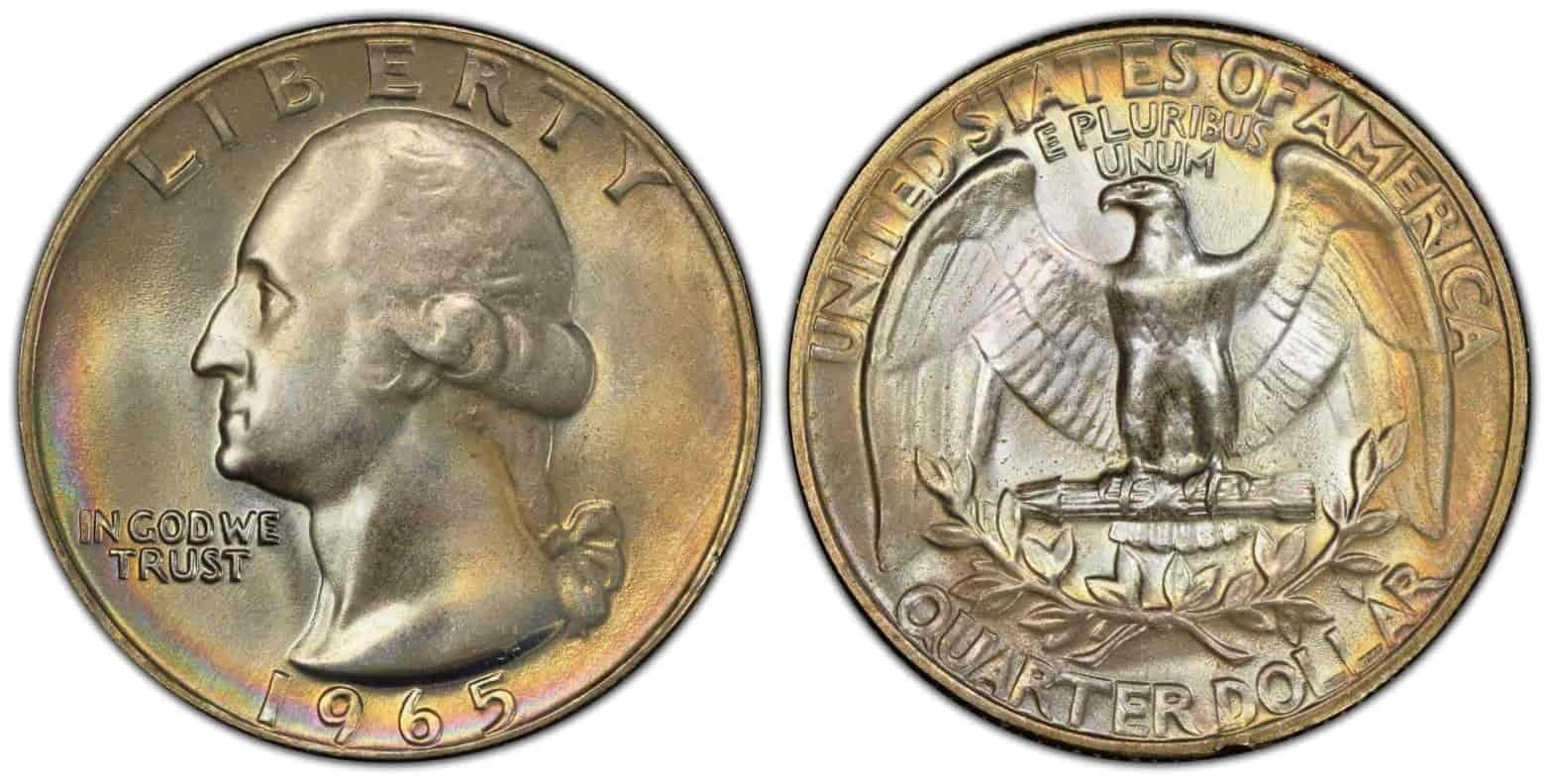
The 1965 Washington Quarter makes this list twice because of its historical significance. It was in 1965 that the United States Mint stopped making U.S. quarters out of 90% pure silver.
1965 Washington quarters can be quite valuable in Mint State, with quarters worth the most money being graded in MS68 condition. The finest known example of the 1965 clad quarter was graded as MS68 and sold for a pretty penny just a few years ago.
The highest recorded auction price for a 1965 Washington Quarter graded MS-68 is approximately $15,000. This high value reflects the coin's exceptional condition and rarity, as MS-68 is a top grade that denotes a nearly flawless example of the 1965 Washington Quarter.
Rare Quarters Worth Money For Sale
You may be surprised to learn how many modern quarters are worth money, much more than melt value. Mint error coins from the U.S. Mints are rare, which makes them some of the most valuable coins.
Whether you’re looking for a rare Standing Liberty Quarter or one of the coveted State quarters, you can always count on Bullion Shark to deliver high-quality products from a variety of sources.
Sources:
1965 25C (Regular Strike) Washington Quarter | PCGS
Washington Quarters 1967 SMS 25C MS | Coin Explorer | NGC
Special Strike Designations | American Numismatic Association
1966 25C (Regular Strike) Washington Quarter | PCGS
FAQ
What quarters are worth money?
Certain quarters are highly valuable due to their rarity, errors, or historical significance. Key examples include the 1796 Draped Bust Quarter, valued in the six-figure range due to its low mintage, and the 1932-D and 1932-S Washington Quarters, the rarest of the series, often worth thousands in high grades. Silver quarters (pre-1965), like the Standing Liberty (1916-1930) and Washington quarters (1932-1964), are sought after for their 90% silver content. Valuable error coins include the 2004 Wisconsin Extra Leaf Quarter, which can sell for hundreds, and the 1999 Delaware Spitting Horse Quarter, a misprint that increases collector demand. Additionally, modern rarities like the 2019-W America the Beautiful Quarters, struck at the West Point Mint with limited circulation, are highly collectible. Always check for mint marks, condition, and errors, as they greatly impact a quarter’s value.
What year quarters are worth money?
Quarters from specific years are worth money due to rarity, errors, or silver content. Pre-1965 quarters, particularly from 1932 to 1964, are valuable because they contain 90% silver, with higher prices for pristine conditions. Key dates include the 1932-D and 1932-S Washington Quarters, often fetching thousands due to low mintage. The 1916 Standing Liberty Quarter is exceptionally rare, with high-grade versions selling for over $10,000. Modern quarters can also be valuable; for instance, the 2004 Wisconsin Extra Leaf Quarter and 1999 Delaware Spitting Horse Quarter are notable error coins that command premiums. Additionally, the 2019 and 2020 West Point Mint quarters (with a "W" mint mark)are scarce, driving collector demand. Quarters from these years can be worth significantly more than face value, especially when in high-grade or containing unique errors.
What bicentennial quarters are worth money?
Bicentennial quarters, minted in 1975 and 1976 to celebrate America’s 200th anniversary, can be worth more than face value, especially if they have rare attributes. While most were struck in clad composition, the 40% silver versions, issued in special collector sets, are more valuable, often selling for $5 to $20 or more depending on condition. High-grade MS67+ bicentennial quarters can fetch hundreds to thousands at auction. Additionally, errors like double die obverses, off-center strikes, or wrong planchet errors can dramatically increase value, with some error coins selling for hundreds of dollars. If you have a bicentennial quarter, checking for silver content, mint errors, and high-grade condition can help determine its worth.
How many quarters in a roll?
A standard roll of quarters contains 40 quarters, totaling $10 in face value. Quarter rolls are commonly used by banks, businesses, and coin collectors for easy storage and transactions. The U.S. Mint and most financial institutions follow this standard count, ensuring consistency in coin packaging. If purchasing quarter rolls from a bank, they typically come in paper or plastic wrappers, while collector rolls, especially those containing silver quarters (pre-1965) or special edition quarters, may be sold in unique packaging. For bulk transactions, a standard box of quarters holds 50 rolls, equating to $500 total. Whether you're a collector searching for rare quarters or simply need change, knowing that each roll contains exactly 40 coins helps with calculations and transactions.
What are quarters made of?
Modern U.S. quarters are primarily made of a clad composition of 75% copper and 25% nickel, forming a durable outer layer over a pure copper core. This composition has been in use since 1965, when the U.S. Mint transitioned away from 90% silver quarters due to rising silver prices. However, quarters minted before 1965, such as Washington quarters from 1932 to 1964, contain 90% silver and 10% copper, making them highly valuable to collectors. Special 40% silver quarters were also issued in 1976 as part of the Bicentennial sets. Additionally, recent collector’s editions, such as America the Beautiful Silver Proof Quarters, are struck in 99.9% pure silver. Understanding the metal composition of quarters helps collectors determine their true value, whether for numismatic appeal or bullion content.
Where to get quarters?
You can get quarters from coin dealers (such as Bullion Shark), coin machines and banks, depending on your needs. If you're searching for specific or rare quarters, coin dealers and coin shows are the best options. For collectors, websites like Bullion Shark offer proof and silver quarters. Whether for everyday use or collecting, these sources provide easy access to quarters.
How many quarters make $10?
To make $10, you need exactly 40 quarters, since each quarter is worth $0.25. This is also the standard amount found in a roll of quarters, which banks and financial institutions use for easy distribution. If you’re exchanging cash for quarters, you can request a quarter roll from a bank, use a coin machine, or get change from retail stores, laundromats, or vending machines. For larger amounts, a box of quarters from a bank contains 50 rolls, equating to $500 total. Whether you're budgeting for laundry, parking meters, or coin collecting, knowing that 40 quarters equal $10 helps with quick calculations and transactions.
What quarters are silver?
Quarters minted before 1965 are silver, specifically the 90% silver quarters issued from 1932 to 1964. These include Washington quarters, which were struck with a composition of 90% silver and 10% copper. These silver quarters are highly valuable to collectors, especially those in high grades or with unique characteristics. Additionally, special 40% silver quarters were issued in 1976 as part of the Bicentennial series, specifically in proof and uncirculated mint sets. Coins like the Standing Liberty Quarters (1916-1930), which were also minted in 90% silver, are another sought-after group. To identify silver quarters, look for coins minted before 1965 or check for silver content through tests, as these are prized by collectors for both their historical significance and precious metal value.
What year did they stop making silver quarters?
The U.S. Mint stopped making 90% silver quarters for circulation in 1964, transitioning to a copper-nickel clad composition starting in 1965 due to rising silver prices. Prior to this, all U.S. quarters, including Washington quarters (1932-1964), Standing Liberty quarters (1916-1930), and Barber quarters (1892-1916), were made of 90% silver and 10% copper. However, in 1976, the U.S. Mint produced special 40% silver Bicentennial quarters as part of collector sets, but these were not released into circulation. Today, the U.S. Mint continues to produce 99.9% silver proof quarters, but these are only available in limited collector’s editions. If you're looking for silver quarters, focus on pre-1965 circulated quarters or special mint sets designed for collectors.
What makes a modern quarter valuable?
Modern quarters can become valuable due to several factors including low mintage numbers, errors during minting, and special commemorative editions. Collector demand also plays a significant role in a coin's value.
Which modern quarters are the most valuable?
Some of the most valuable modern quarters include:
- The 1999-P Connecticut Broadstruck Quarter
- The 2004-D Wisconsin Extra Leaf Low and High Quarters
- The 2005-P Minnesota Doubled Die Quarter
- The 2005-P Kansas "In God We Rust" Quarter
- The 2008-D Oklahoma Quarter with Extra Cactus Leaves
- The 2012 Denali Quarter with a Mint Error
- The 2020-W V75 Privy Mark Quarter
How can I find valuable modern quarters?
Valuable modern quarters can sometimes be found in circulation. Checking your change, buying rolls of quarters from banks, and trading with other collectors are common ways to find these coins. Paying attention to new releases from the U.S. Mint and special commemorative issues can also lead to discovering valuable quarters.
What is the value of the 2004-D Wisconsin Extra Leaf Quarters?
The 2004-D Wisconsin Extra Leaf Low and High Quarters are among the most sought-after modern quarters. Depending on their condition and the market, these coins can be worth hundreds to over a thousand dollars.
Are there any valuable state quarters?
Yes, several state quarters are considered valuable due to errors or variations. Examples include the 2004-D Wisconsin Extra Leaf Quarters and the 2005-P Kansas "In God We Rust" Quarter.
What should I do if I find a valuable modern quarter?
If you find a valuable modern quarter, consider having it graded by a professional grading service like PCGS or NGC. This can help verify its condition and authenticity, potentially increasing its value. It's also advisable to consult with a reputable coin dealer or collector for further advice.
How do I store and care for valuable modern quarters?
Valuable modern quarters should be stored in a cool, dry place. Use coin holders, capsules, or albums designed for coin storage to protect them from damage and environmental factors. Avoid handling the coins directly to prevent scratches and wear.
What years of quarters are worth money?
Pre-1965 Silver Quarters: Quarters minted before 1965 are composed of 90% silver, making them valuable based on their silver content alone. As of recent years, their value in silver is several times their face value.
- 1932-D and 1932-S Washington Quarters: These are the first year of issue for Washington quarters and had very low mintage numbers, making them particularly sought after by collectors.
- Standing Liberty Quarters (1916-1930): Early years of this series, especially those from 1916 to 1924, are highly valued. The 1916 Standing Liberty quarter is particularly notable for its rarity and high value.
- 1940-D, 1936-D, 1937-S: Some quarters from the Washington series in specific mints and years are rarer than others, making them more valuable.
- 1950-D/S Over mintmark (OMM) Quarters: This variety where the D mintmark was struck over an S mintmark is a rare error and is sought after by collectors.
- 1970 Quarter Struck on 1941 Canadian Quarter: This is an example of a mint error where a 1970 quarter was struck on a 1941 Canadian quarter. Mint errors can be very valuable, depending on their uniqueness and the story behind them.
- 1983-P and 1983-D Washington Quarters: These quarters are scarce due to low mintages and few being saved in high grades, making mint-state examples particularly valuable.
- Statehood Quarters with Errors: Some state quarters also carry value, especially if they have notable errors like off-center strikes, doubled dies, or other mint mistakes.
- 2019-W Quarters: These are part of a recent initiative by the U.S. Mint to stimulate interest in coin collecting. Quarters with the "W" mintmark were released directly into circulation and are quite collectible.
- 2020 Bat Quarter Error: The National Park of American Samoa quarter, which features fruit bats, has some known errors like double dies that can make specific coins more valuable.
What quarter is worth $2000 right now?
The 1932-D Washington quarter had a relatively low mintage of 436,800 pieces, making it one of the rarest in the series. The value of this quarter in higher grades (uncirculated conditions) can significantly exceed $2,000. For example, in grades like MS-63 or higher, the price increases substantially, often selling for several thousand dollars at auctions or from coin dealers, depending on the coin's condition and the market conditions at the time.
Which quarter is worth $10,000?
One quarter that can be worth $10,000 or more is the 1916 Standing Liberty quarter. This particular coin is highly valued due to its rarity and historical significance. It was the first year of issue for the Standing Liberty quarter series, which ran from 1916 to 1930, and it features a design by sculptor Hermon Atkins MacNeil.
The 1916 Standing Liberty quarter had a very low mintage of only 52,000 coins, making it one of the rarest quarters in American coinage. In addition, the coin's design includes Liberty in a flowing gown passing through a gate between two walls, which was controversial at the time and led to a redesign in subsequent years. This controversy and the short production run have made the 1916 Standing Liberty quarter highly sought after by collectors.
Why is 1965 quarter so rare?
There are collectors who specialize in the "transitional" coins—the first years when the Mint switched from silver to clad. For these collectors, a 1965 quarter might hold more interest and perceived value, especially in higher grades (MS-65 and above), but it still would not be considered rare in the broader market.
How do I determine the grade of my modern quarter?
Determining the grade of a modern quarter involves a detailed examination of the coin's condition, focusing on aspects such as luster, strike, and the presence of wear or damage. The grading scale used by most collectors and grading services ranges from Poor (P-1) to Perfect Mint State (MS-70) for uncirculated coins, and from About Good (AG-3) to Proof (PR-70) for proof coins. To accurately determine the grade of your quarter, you should compare it against standard grading guidelines provided by reputable coin grading services like the Professional Coin Grading Service (PCGS) or the Numismatic Guaranty Corporation (NGC). However, for an official grade, submitting your coin to these services is recommended, as they can provide a professional and unbiased assessment.
Where can I sell my valuable modern quarters?
If you find yourself in possession of a valuable modern quarter and wish to sell it, there are several avenues you can explore. Coin dealers, both local and online, are often interested in purchasing valuable coins for their inventory. Auction houses, especially those specializing in numismatic items, can be an excellent option for rare or highly valuable quarters, offering the potential for higher sale prices. Online marketplaces and forums dedicated to coin collecting also provide platforms for selling directly to collectors. When selling valuable coins, it's important to have a clear understanding of their market value and to consider obtaining a professional grade to maximize their appeal to potential buyers.
Are there any modern quarters with errors not listed in the article that could be valuable?
Beyond the specific examples listed in the article, there are indeed other modern quarters with errors that could be valuable. Mint errors can range from off-center strikes, double dies, and misprints to more unique errors such as wrong metal compositions or overstrikes. Collectors often seek out these error coins, and their value can vary widely based on the rarity and nature of the error. To identify potential error coins, pay close attention to any irregularities in the coin's appearance and consult resources or experts specializing in error coins to learn more about these unique collectibles and their potential value.
Continue Reading:
- How the Flaw in Buffalo Nickels Launched the Hobo Nickel Movement
- 1944 Wheat Penny Value
- 7 Valuable Coins From the 1800s
- The History of the Sacagawea Coin
- 9 of the Most Valuable State Quarter Errors Worth Money
- Collecting Roosevelt Dimes: History, Values and Key Dates
- Top 10 Rare Quarters Worth Money List
- 1955 Wheat Penny Value
- Top 100 Pennies Worth Money
- 1956 Wheat Penny Value
- Certified / Graded Morgan Silver Dollars
- Indian Head Penny Value
- What makes a 1964 Kennedy Half Dollar Rare?



